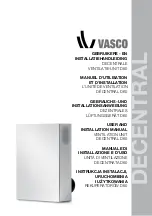
5
Electrical connection
5.1
To do before the electrical
connection
• Make sure that the electrical connection agrees with the
product specification on the motor name plate.
• Make sure that the environment for electrical connection
is clean and dry.
• Make sure that the wiring diagram that is included with the
supply of the product agrees with the terminals in the con-
nection box.
5.2
To connect the product to the
power supply
• Complete the electrical connection for the motor. Refer to
the motor wiring diagram that is included with the product.
• Make sure that the cross section of the protective earthing
is equal to or larger than the cross section of the phase
conductor.
• Install a circuit breaker in the permanent electrical installa-
tion, with a contact opening of a minimum 3 mm at each
pole.
• If a residual current device (RCD) is installed, make sure
that it is an all-current sensitive RCD. Consider if the prod-
uct has a frequency converter, uninterruptible power sup-
ply (UPS), or an EC motor. EC motors have a leakage
current to earth that is <=3.5 mA.
5.3
Speed controller for AC
motors
Note:
The speed controller alternatives are different for different
motor types. Make sure that your motor is compatible with
the speed controller type before you use it.
The speed can be controlled by voltage reduction using a
transformer. It is also possible to control the fan speed with
frequency converter if the installed frequency converter has
built in all-pole sine filter and shielded cables are not needed.
5.4
To install motor protection for
AC motors
• If the product has an built in motor protection, reset by dis-
connecting the product from power for 60 seconds.
• If the motor has temperature monitors such as thermal
contacts (TK) or thermistors lead out into the terminal box,
these must always be connected in the control circuit us-
ing appropriate motor protection.
• Make sure that an overheated motor cannot start again
automatically when it becomes cool.
• Install the motor cables and the temperature monitor apart.
• If the motor does not have temperature monitors, install a
motor protection switch.
6
Commissioning
Caution
• If strong vibrations occur during
commissioning, immediately increase
or decrease the fan speed until the
vibrations are decreased. Continuous
strong vibrations can cause damage
to components.
• Do not increase the fan speed to a
higher rpm value than the maximum
value that is given on the name plate.
The commissioning report is found at www.systemair.com.
6.1
To do before the
commissioning
• Make sure that the installation and electrical connection
are correctly done.
• Visually examine the product and accessories for damage.
• Make sure that the safety devices are correctly installed.
• Make sure that there are no blockages in the air inlet and
the air outlet.
• Make sure that installation material and unwanted objects
are removed from the product and the ducts.
6.2
To do the commissioning
1
Set the installed safety switch in the OFF position.
2
If it is possible to get access to the fan impeller, do the
steps that follows:
a.
If it is necessary, remove parts of the installation.
b.
Turn the fan impeller by hand and make sure that it
turn easily.
c.
Record the result in the commissioning report.
3
Make sure to turn the product in a direction that agrees
with the related arrow on the product.
a.
Record the result in the commissioning report.
4
If you removed parts of the installation to get access to
the fan impeller, install the removed parts again.
5
Set the installed safety switch in the ON position.
6
Start the product.
7
Set the minimum operation speed.
8
Increase the operation speed gradually to the maximum
operation speed.
a.
Examine the vibrations in the casing and the bearing
areas at all speed levels.
b.
Make sure that the vibrations agree with the specifi-
cations in DIN ISO 14694.
c.
Make sure that none of the speed levels cause un-
wanted noise in the product.
d.
Record the result in the commissioning report.
9
Record the necessary data in the commissioning report.
7










































